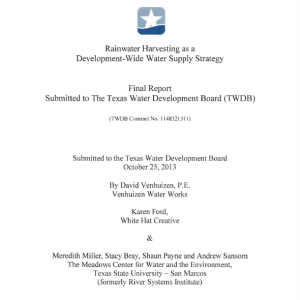Rainwater Harvesting as a Development-wide Water Supply Strategy

This final report was submitted to the Texas Water Development Board (TWDB) in Oct. 2013. The study investigated residential-scale rainwater harvesting systems as a water supply strategy for whole developments. It envisions collecting rainwater from building roofs and routing it to a free-standing cistern on the same lot. Each building or building cluster would incorporate a self-contained water sypply system, including all facilities required to filter/treat/disinfect the water to meet all water demands within and and around the building(s). All buildings may be connected to a development-wide water system through a backup supply scheme to assure a continuous water supply during drought periods. This strategy may also include arrangements for all residential-scale facilities to be maintained collectively by a management entity.
This investigation evaluated the fiscal, societal and environmental feasibility of this strategy, as well as how to properly implement and manage it to provide continuous water supply to development water users, particularly regarding its drought implications. In fact, all conventional water supply strategies comprise rainwater harvesting systems that utilize the whole watershed as the collection area, and a reservoir, aquifer or river as a “cistern.” These large-scale rainwater harvesting systems are as dependent on rainfall, and the proper sizing of the storage vessel(s), as a residential-scale RWH system. When severe drought occurs, water demands must be reduced and/or an additional supply must be accessed with either system. Examining a residential-scale RWH system entails considerations of the required facilities, the costs, the sustainability, the governance requirements, and the marketability of buildings under the conditions required to ensure a residential-scale RWH strategy as a drought-proof water supply system.
This investigation focused on the Texas Hill Country, where aquifers are under stress, and for which it would generally be very expensive to import water through regional pipelines. Thus, residential-scale RWH merits an alternative consideration. The applicability of this strategy in other areas of the state was also reviewed.